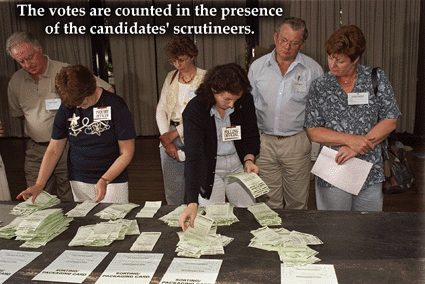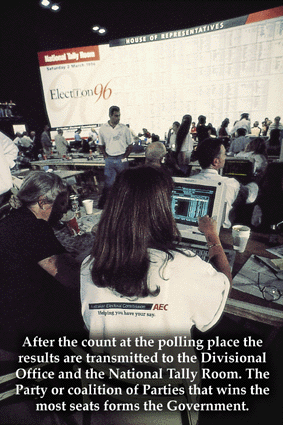1996 Election Report: Election Night
Updated: 5 December 2007
Election Night
The counting of votes, known as the scrutiny, begins as soon as polling places close their doors at 6pm on polling day. Only ordinary votes are counted on election night.
Counting at polling places

Polling officials are required to complete four main tasks at the close of polls:
- they are required to count the first preferences on the House of Representatives ballot papers
- they conduct a two-candidate preferred count (or TCP)
- they count the first preferences on the Senate ballot papers and
- they count and sort the declaration vote envelopes (these remain unopened).
A two candidate preferred count (or TCP) is a distrbution of preferences to the two candidates most likely to come first and second. Often (but not always) these will be candidates from the Australian Labor Party or the Coalition (Liberal and National Parties). The TCP is conducted to give an early indication of who is most likely to win each seat since this is not always clear from first preferences.
How it's done:
- immediately after the doors close polling officials empty the ballot boxes
- ballot papers are unfolded and sorted into first preference votes for each candidate
- ballot papers that are informal are set aside
- the House of Representatives votes are counted first
- all the number '1' votes (first preferences) are counted for each candidate and put into separate piles
- the informal ballot papers are counted
- the first preference results are tabulated and phoned through to the DRO, along with the number of informals
- the DRO enters the results for each polling place into the AEC's national computerised Election Night System (TENIS)
- these results are transmitted to the National Tally Room (NTR) in Canberra where they are placed on the National Tally Board and are available to the media
- following the House of Representatives count polling officials conduct the TCP count
- the TCP results are phoned to the DRO, entered into TENIS and transmitted to the NTR
- lastly, the Senate first preference votes are counted and phoned to the DRO to relay to the NTR
- as soon as the scrutiny of ordinary votes is finished, polling officials place the ballot papers and declaration vote envelopes in sealed parcels and deliver them to the DRO
- declaration votes (pre-poll, postal, absent and provisional) are scrutinised at the Divisional Office after election night.
On election night, there is no release of Senate results other than first preferences for groups and ungrouped candidates. Because Senate results cannot be calculated until the State-wide total of votes used to determine the "quota" is known, it is usually not possible to get more than a general impression of the Senate results on polling night itself.
Candidates are not allowed to be present at the counting of votes, however, scrutineers who are appointed by candidates to represent their interests, closely observe all counting of votes throughout the election process until counting is completed.
Approximately 88% of votes are counted on election night. The counting of the remaining 12% (pre-poll, postal, absent and provisional) begins on the Monday after polling day.
National Tally Room

The National Tally Room (NTR) is set up to provide a central point for the display of results. Results are transmitted via the computerised TENIS from every Divisional Office around Australia and displayed on a manual tally board which dominates the room. The results are also displayed on computer terminals which are available to print and radio journalists, as well as directly fed to the television networks. The NTR is the main venue for television coverage of an election.
This election the venue for the NTR was the Australian Institute of Sport, in Canberra, as the normal venue, Exhibition Park, was unavailable as a result of the Royal Canberra Show being held there shortly before polling day.
To ensure the smooth running of the NTR the AEC conducted a rehearsal on the Thursday before polling day to test the computer system and to provide training for the casual staff employed to work behind the tally board. Back-up procedures, in case the computers crashed, were also tested. A rehearsal for the television networks was held the following day.
National Tally Room logistics
- the NTR took two weeks to construct – this included the construction of television studios – and one week to dismantle
- it took three days to "dress" the tally board with candidates' names, party affiliations and other signage
- two complete layers of chipboard were laid over the wooden parquetry floor of the Indoor Sports Arena (usually a basketball court)
- it cost the AEC approximately $869 000 to run – this included the hire of venue, communication facilities, equipment hire, casual staff wages, and security. (The television networks met the costs of constructing their own studios)
- throughout the week prior to polling day and on polling day itself security guards were employed by Telstra (at the AIS) and by the AEC (at its Central Office in Canberra) to protect the telecommunications network cables set up to transmit election results.
During the course of the evening approximately 2 300 people were in the NTR at any one time. This included:
- 238 AEC staff and staff of support organisations
- 871 members of the media (radio, print and television)
- 122 political party workers or Members of parliament
- 3 500 members of the public (a maximum of about 900 at any one time)
- 92 international and other official guests.
On the technical side there were:
- 40 terminals, 4 printers and 11 separate data feeds
- 4 kilometres of telephone cables
- 8 kilometres of computer cabling
- 2 mobile telephone repeater stations
- in excess of 300 mobile and 200 static telephones
- 55 peripherals off the AEC computer system
- up to 680 amps of electrical load (enough to power a small town).
A radio link was established between the NTR and the AEC's Central Office as a backup communications link.
The AEC provided the then Prime Minister, Mr Keating, and the then Leader of the Opposition, Mr Howard, with computer terminals directly linked to the election results system.
Approximately 82 500 transactions were processed on election night, and over 440 terminals and printers were used across the country.



